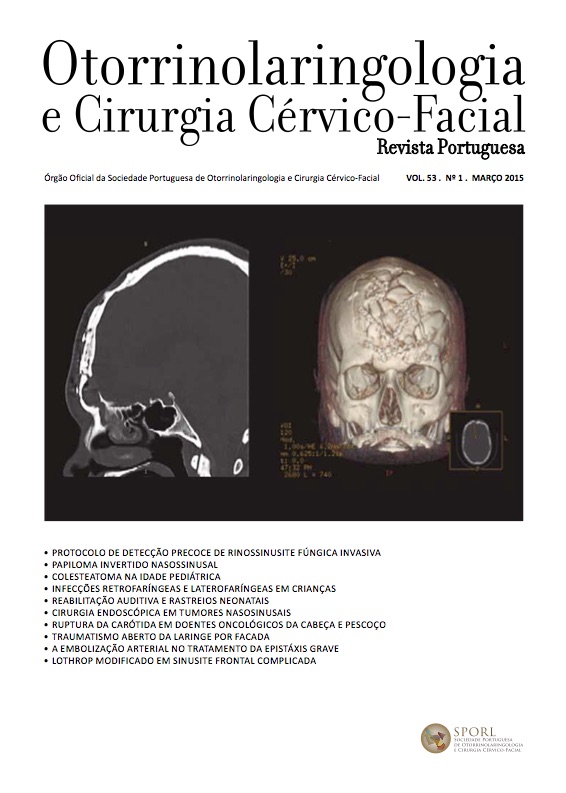Nasosinusal inverted papilloma: A review of eight years
DOI:
https://doi.org/10.34631/sporl.556Keywords:
nasosinusal inverted papilloma, nasal benign tumor, endoscopic sinus surgeryAbstract
Objectives: To analyze a case series of nasosinusal inverted papilloma (NIP) at Hospital Garcia de Orta. Methods: Retrospective study of the NIP cases diagnosed between 2007 and 2014. Epidemiological, clinical and therapeutic parameters were analyzed.
Results: There were 13 cases of NIP, predominantly male (61.54%) with mean age of 57.4 ± 15.0 years. The most frequent presurgical symptom was unilateral nasal obstruction in 77% of cases. There were no cases of bilateral NIP. The recurrence was 30.8%, with first recurrence mean time of 22 months, being the nasal endoscopic surgery the choice approach (61,5%). In a case, malignant transformation of NIP was found (7.7%).
Conclusion: Inverted papilloma is a tumor with nonspecific symptoms. Endoscopic treatment of NIP is increasingly being accepted as the first-line surgical technique to which an external approach may be associated. Annual endoscopic and surveillance is recommended for several years in order to early detect possible recurrences.
Downloads
References
– Barnes L, Eveson JW, Reichart P, Sidransky D, editors. WHO Classification of Tumours. Pathology and genetics of head and neck tumours, Vol. 9. Lyon: IARC Press; 2005. p. 28–32
- Díaz Molina JP, Llorente Pendás JL, Rodrigo Tapia JP, Álvarez Marcos C, Obeso Agüera S, Suárez Nieto C. Papilomas invertidos rinosinusales, Revisión de 61 casos. Acta Otorrinolaringol Esp. 2009;60:402–8
- Llorente Pendás JL, Suárez Fente V, Suárez Nieto C. Papilomas invertidos nasosinusales. Acta Otorrinolaringol Esp. 2007;58:78–83
- Peng, P. Har-El, G. Management of Inverted Papilloma of the nose and paranasal sinuses. American Journal of Otolaryngology - Head and Neck Medicine and Surgery 2006 Vol.27 p233-7
– Alegre ACM, Ramos AHC, Voegels RL, Romano F. Papiloma e Papiloma invertido Em: Campos CA, Costa HOO. Tratado de Otorrinolaringologia. 1A ed. São Paulo: Roca; 2003. p126-32
- Baruah P, Deka RC. Endoscopic management of inverted papilomas of the nose and paranasal sinuses. Ear, Nose & Throat Journal 82(4):317-20,2003;82(4):317-20
– Lawson W, Ho B, Shaari C, Biller H. Inverted papilloma: A report of 112 cases. Laryngoscope. 1995;105:282–8
- Buchwald C, Franzmann MB, Tos M. Sinonasal papillomas: A report of 82 cases in Copenhagen Country, including a longitudinal epidemiological and clinical study. Laryngoscope. 1995;105:72–9.
- Carta F, Verillaud B, Herman P. Role of endoscopic approach in the management of inverted papilloma. Curr Opin Otolaryngol Head Neck Surg. 2011;19:21–4
- Wang D., Li Y., Sunk “ Nasal inverted papilloma and human papilloma virus”. Lin Chuang Er Bi Yan Hou Ke Za Zhi 1998 Marz 12(3):118-119
- Huang CC, Lee TJ, Chang PH, Lee YS, Chuang CC, Jhang YJ, et al. Desmoglein 3 is overexpressed in inverted papilloma and squamous cell carcinoma of sinonasal cavity. Laryngoscope. 2010;120:26–9
- Bhalla RK, Wright ED. Predicting the site of attachment of sinonasal inverted papilloma. Rhinology 2009; 47: 345-8
- Karkos PD, Khoo LC, Leong SC, et al.Computed tomography and/or magnetic resonance imaging for preoperative planning for inverted nasal papilloma: review of evidence. J Laryngol Otol 2009; 123: 705-9
- Krouse JH. Development of a staging system for inverted papilloma. Laryngoscope 2000; 110: 965-8
- Karkos PD, Fyrmpas G, Carrie SC, Swift AC. Endoscopic versus open surgical interventions for inverted nasal papilloma: A systematic review. Clin Otolaryngol. 2006;31:499–503
- Jurado-Ramos A, Gutiérrez Jodas J, Romero FR, Alarcón Linares E, Muñoz Del Castilllo F, Muñoz Gomariz E, ET AL. Endoscopic medial maxillectomy as a procedure of choice to treat inverted papillomas. Acta Oto-laryngologica 2009;129(9):1018-25
- Lawson W,Kaufman MR,Biller HF.Treatment outcomes in the management of inverted papillomas: An analysis of 160 cases. Laringoscope 2003;1548-56
- Lund, V., Stammberger, H., Nicolai, P., et al . European Position on Paper on Endoscopic Management of Tumour of the Nose, Paranasal Sinuses and Skull Base. Rhinol Suppl. 20100. 1-143
- Sham CL, Woo JK, van Hasselt CA, Tong MC. Treatment results of sinonasal inverted papilloma: an 18-year study. Am J Rhinol Allergy. 2009;23: 203–11
- Moon IJ, Lee DY, Suh MW, Han DH, Kim ST, Min YG, Lee CH, Rhee CS. Cigarette smoking increases risk of recurrence for sinonasal inverted papilloma. Am J Rhinol Allergy. 2010 Sep-Oct;24(5):325-9
- Busquets J, MD, Hwang P, MD. Endoscopic Resection of Sinonasal Inverted Papilloma: A Meta-analysis. Otolaryngol Head Neck Surg 2006; 134: 476-82
- Atlung T, Sunar A, Bilgin H. Inverted papilloma. Report of a multicentric case. Rev Laryngol 1989;110:299-301
– Lawson W, Patel Z. The evolution of management for inverted papilloma: An analysis of 200 cases. Otolaryngol Head Neck Surg. 2009;140:330–5






